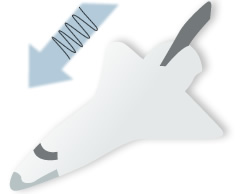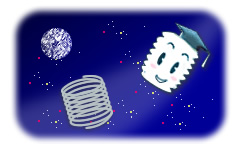
Episode 20: Space Shuttle Springs
Hello everyone. Now, in Japan, the cost for traveling on the highways has been set at 1,000 yen for Saturdays, Sundays and holidays, so…there are traffic jams everywhere you go. I’m sure we’re all happy for the lowered rate, but…aren’t traffic jams the worst!?
We in Japan experienced, on July, 22nd, the first total eclipse of the sun in 46 years.
Unfortunately, many regions were overcast; I wonder if many people were able to experience the shadow of the moon anyway.
And…if you looked into the sky… Japanese experiment module “Kibo” was active on the international space station (ISS) that was completed on July 19th. Already…27 years have passed since the conceptual beginning of the ISS. This was a terrific milestone for Japan’s space development efforts.

Mr. Koichi Wakata (45 years old), Japan’s famous astronaut, experienced a long-term sojourn in the ISS, and through the cooperation of his fellow astronauts during an EVA (or extra-vehicular activity) was able to extract a facility from the space shuttle Endeavour’s cargo bay using its robot arm. This facility was attached to the leading end of the onboard Kibo laboratory, already an active part of the ISS.
Actually, the space shuttle uses a lot of springs.
Spring forces are used on the space shuttle docked with the ISS to push toward the front of the ISS when the astronauts are ready to return to Earth. They separate from the ISS a distance of up to 400 feet (approximately 122 meters). After that, the Endeavour’s engines thrust to separate even further from the ISS and return to land at NASA’s Kennedy Space Center (or KSC).

That was when Mr. Wakata finally was able to return to Earth after a four-month-and-a-half stay in space. Four months and a half are really a long time… I don’t think that I could ever last so long in such an environment.
Did you know that springs are also used on the space shuttle to separate from the booster rockets after lift-off? The springs used in the space shuttle must function perfectly under a variety of conditions. That’s why the space shuttle employs an alloy called titanium in addition to the other metals we can easily find here on earth. The reasons are that titanium is light and does not rust, and it is highly compatible with humans, and does not cause allergies. Titanium possesses the right elasticity required in such springs, so the space shuttle uses them everywhere. Even in our daily lives, springs are used in wristwatches and as frames for eyeglasses.
A resin called zirconia is also used for springs. Zirconia is often used as a material for treating teeth without using metal.
The development of such new materials is indispensible in space development.
In the last several years, NASA has been developing an article called low-impact urethane that is a highly popular product for pillows and mattresses. During lift-off of the space shuttle, astronauts’ bodies are subjected to extremely high G-forces. To alleviate any damage caused during high-G periods, the astronauts’ seats in the space shuttle are lined with this low-impact urethane material. Interestingly, if you think about it…low-impact urethane also acts as a spring, doesn’t it!

As I just mentioned, the space shuttle has a wide variety of springs ranging from the very small to the very large. There are many types, such as coil springs, disc springs, and leaf springs.
This is as far as I can go this time.
Sometimes, when I am on an airplane and happen to look at the GPS screen, I can see information on our altitude, our air speed and the outside air temperature. I am always amazed that the outside air temperature at altitudes often flown on international flights can be as low as -50°!
Even on hot summer days, as I look up into the sky and mop the sweat from my brow, I can hardly believe that the sky above is actually -50°. The absolute temperature of space is 2.7°. Absolute temperature uses -273.15°C, which is the low temperature limit (the low temperature limit at which molecules cease to be active) as absolute 0°. And space…my is it cold…it is only slightly warmer, 2.7° warmer than absolute zero. In Celsius, that translates to -270.45°. Isn’t it just incredible that the space shuttle can operate under such conditions, and in such a cold environment? My…that is just inconceivably cold…
Anyway, I hope you all stay cool this summer, but not THAT cool!
Written by Banekko (a child of spring)

